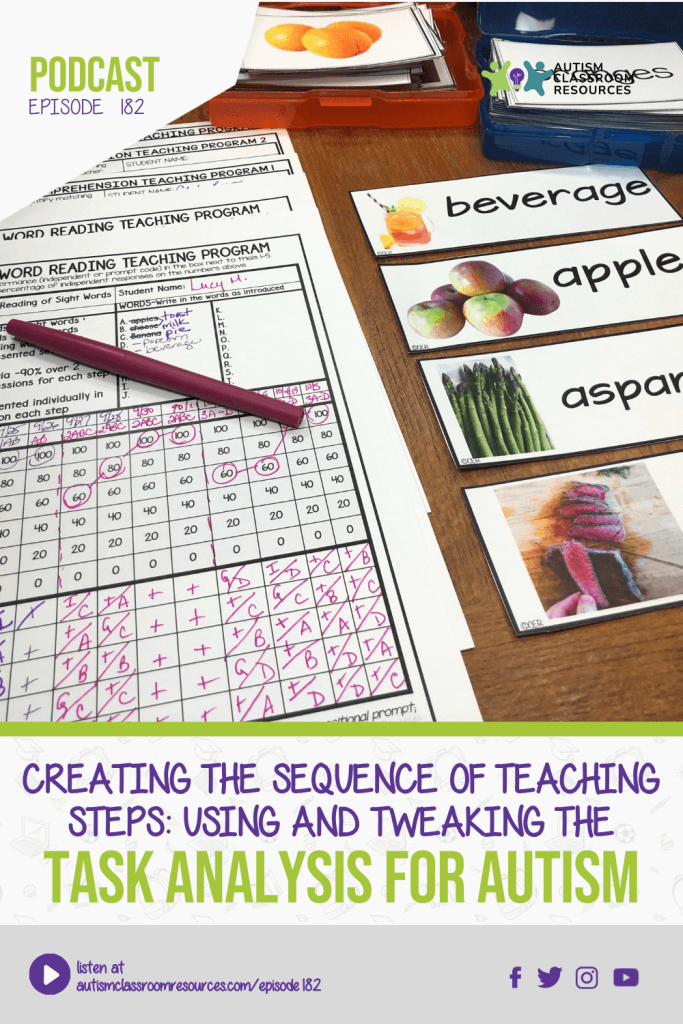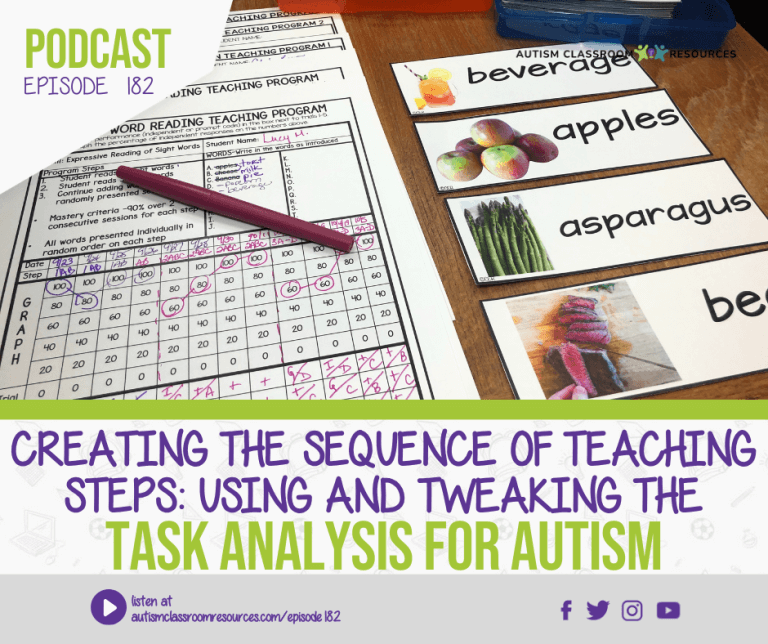Welcome to the Autism Classroom Resources Podcast, the podcast for special educators who are looking for personal and professional development.
Christine Reeve: I’m your host, Dr. Christine Reeve. For more than 20 years, I’ve worn lots of hats in special education but my real love is helping special educators like you. This podcast will give you tips and ways to implement research based practices in a practical way in your classroom, to make your job easier and more effective.
Welcome back to the Autism Classroom Resources Podcast. I’m Chris Reeve, and I’m your host. And currently we’ve been talking about the seven elements for effective instruction for learners with autism in little bite sized episodes.
Last week, I talked about how making sure that your target skills are clearly defined is so important. Now today, I want to talk about how we take those skills and break them down into their component parts. Behavior analysts call those task analyses and we use them a lot in special ed. But they come in different formats. And there are different elements to consider.
Teaching in a systematic manner, though, step by step can really eliminate your decision fatigue, because you already have your steps written down, you don’t have to think about the next one on the fly. And it also makes your instruction much more efficient. This episode is bite sized. So I better get started.
When you prepare task analysis, essentially what you’re doing is you’re breaking the skill down into its component parts and people call them pinpoints. You list all the the behaviors or the skills that you want to see to make up that task in order. And then you address the acquisition of each skill separately in a sequence or replacing each other. So there’s there’s actually a couple different ways that it can be used.
We can have a task analysis that is I do one thing, which leads me to the next thing, which leads me to the next thing. I can also have it where it’s one thing, and then I do that thing with something else, that thing with the next thing. And so it all just turns into a bigger behavior.
So let me give you a quick example. So if we’re thinking about something that happens in the chain, something like washing your hands or getting dressed or doing a math problem or using a calculator, you could also do a task analysis for, we typically will teach them with two different teaching strategies. And I will put a link to a blog post I have about backward chaining and forward chaining in my blog so that if you need more information about it, but essentially all we’re doing in any kind of chaining procedure is we’re teaching one step in isolation by itself.
Now, a task analysis that works well with a chain is something where I go in the bathroom is my first step. I turn on the water, that’s my second step. I put my hands under the water. So I’m describing the steps of washing your hands. And each one happens after the other. The chaining processes just in which ones are we prompting and reinforcing for at this moment in time.
So I’m not going to worry about those today. We’re just worried about our little seven bite sized pieces. So a hand washing task analysis might be go to the sink, turn on the water, get the soap, rub it on your hands, rinse your hands, turn off the water, get a towel, throw the towel away.
So each one of those leads to the next thing, I can’t rub the soap on my hands if I never got the soap out of the soap bottle or got this bar of soap or whatever we’re using. So it’s a skill that one thing leads to another leads to another.
You can also have what’s called a shaping task analysis, which is where we are teaching what we call successive approximation where each skill replaces the one that came before it. So let’s think about a teaching objective that involves participating in a group activity for 25 minutes. We don’t want to throw the student in for 25 minutes and see if he can stay. That’s assessing the skill, but it’s not teaching the skill because we’re not actually breaking it down into smaller parts. And that’s why this step is so important.
Many people don’t realize it, but task analyses are really perfect for this kind of tasks. This increased participation. We need to break the skill down into small components and teach each one. But this time, instead of it being a step that they do each time, you’re going to start with participating, say five minutes if that’s where he starts. Maybe you know from your assessment he can sit for five minutes and that’s it.
So we’re going to start with where he’s successful. Then we’re gradually going to have him sit for seven minutes and then we’re going to have him sit for eight minutes. And then we’re going to have him sit for 10 minutes and each time he’s able to do that to a specific criteria, we’re going to reinforce it, and I’ll talk about reinforcing later in another episode. But we’re gradually going to increase the amount of time that he stays and is successful.
Finally, there are reasons for whatever type of task analysis or program you’re using, that you want to write the steps down. The way that you wash your hands may not be the way that a paraprofessional in your class washes their’s. We don’t all do things exactly the same way. Imagine how confusing it would be, if every day the steps or the order of the steps were changed for your students to wash their hands.
If it’s a shaping strategy, like increasing the time in the group, then it’s important to write it down to make sure that everybody knows what our criteria is right now for how long he has to remain on his own, and what criteria gets reinforced. There’s obviously a lot that goes into shading and shaping as teaching strategies and I will put some links to blog posts about that in the show notes. And that includes a post about how chaining procedures for instruction where we just teach that one step at a time can actually save you a ton of time in the classroom and get you better results. So I’ll put those in the show notes.
That’s our bite sized episode for the sequence and teaching steps and task analysis. Your action item this week is to take one of the skills that you’re teaching, and check to see if you have the skill broken down into composite steps. If you use something like the STAR curriculum, you might have that already, because they provide that as part of their instructional kit. But if not, start to think about writing the steps down and sharing them with the staff so everyone’s on the same page with a systematic instruction of the skill.
And hang on to it because next week, we’re going to be talking about choosing the materials you use in instruction to get the best results. And if you’re enjoying the series or the podcast as a whole, I’d love for you to hop over to Apple podcasts and share a review. I’ll put the link to that in the show notes. Or if reviews aren’t for you. Share it with another teacher friend or on social media. My goal is to always make your jobs easier, and to help teachers across the board become more effective. So if you think that the podcast has helped you with that, sharing is a great way for you to expand that effort and I would really appreciate it. And as always, thanks for being here. Thanks for listening.
Thanks so much for listening to today’s episode of the Autism Classroom Resources podcast. For even more support, you can access free materials, webinars and Video Tips inside my free resource library. Sign up at autismclassroomresources.com/free. That’s F-R-E-E or click the link in the show notes to join the free library today. I’ll catch you again next week.







